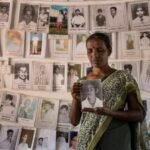
The Systematic violence and discrimination against the Tamil ethnic minority in Srilanka
The Tamil genocide in Sri Lanka refers to the systematic violence and discrimination against the Tamil ethnic minority, particularly during the Sri Lankan Civil War (1983-2009). The conflict was rooted in ethnic tensions between the Sinhalese majority and the Tamil minority, who sought greater autonomy and recognition of their rights.
Key factors contributing to this tragic event include:
1. **Political Marginalisation**: Tamils faced political disenfranchisement and were often excluded from key government positions and decisions.
2. **Cultural Suppression**: There were efforts to promote the Sinhalese language and culture at the expense of Tamil identity, leading to feelings of alienation among Tamils.
3. **Ethnic Violence**: The situation escalated with violent incidents, including pogroms against Tamils, which intensified demands for independence.
4. **Civil War**: The conflict saw the rise of the Liberation Tigers of Tamil Eelam (LTTE), a militant organisation that fought for an independent Tamil state. The government responded with military force, leading to widespread atrocities.
5. **Human Rights Violations**: During the final stages of the war, there were numerous reports of war crimes, including mass killings, disappearances, and the targeting of civilians.
The aftermath has left deep scars in Sri Lankan society, and calls for accountability and reconciliation continue to be significant issues in the country. The topic remains sensitive and complex, with various perspectives on the conflict and its legacy.
Here’s a deeper exploration of the various aspects and impacts of diaspora activism in addressing human rights issues globally:
### 1. **Historical Context**
– **Emergence of Diaspora Activism**: Diaspora activism has roots in historical migrations due to conflict, persecution, or economic hardship. As communities settled in new countries, they often maintained connections to their homelands, leading to the formation of networks aimed at addressing various issues, including human rights.
### 2. **Key Features of Diaspora Activism**
– **Identity and Belonging**: Many diaspora activists are motivated by a strong sense of identity and belonging to their home countries. This emotional connection drives their commitment to advocating for change and justice.
– **Transnational Advocacy**: Diaspora activists often operate across borders, using their unique positions to bridge gaps between local struggles and international support, making their activism transnational in nature.
### 3. **Strategies Employed by Diaspora Activists**
– **Digital Activism**: The rise of the internet and social media has transformed diaspora activism. Activists use online platforms to share information, organize campaigns, and mobilize supporters globally. Hashtags and viral campaigns have proven effective in raising awareness.
– **Grassroots Mobilization**: Beyond digital efforts, many diaspora groups organize grassroots movements in their host countries, holding rallies, protests, and community events to create visibility and pressure for change.
### 4. **Case Studies of Effective Diaspora Activism**
– **Rwandan Diaspora**: Following the Rwandan Genocide in 1994, the Rwandan diaspora played a pivotal role in advocating for justice and accountability, raising funds for survivors, and supporting reconciliation efforts.
– **Syrian Diaspora**: In the wake of the Syrian Civil War, activists in the Syrian diaspora have organized protests, raised funds for humanitarian aid, and lobbied foreign governments to support displaced populations and hold perpetrators accountable for war crimes.
### 5. **Challenges Faced by Diaspora Activists**
– **Political Repression**: Many diaspora activists face threats from their home governments, including harassment or even violence against them and their families. This can create a chilling effect on activism.
– **Fragmentation**: Diaspora communities can be divided along political, ethnic, or ideological lines, which may hinder collective action and advocacy efforts.
– **Resource Constraints**: While some diaspora groups are well-funded, others struggle to secure the necessary resources for effective advocacy, limiting their impact.
### 6. **Impact on Home Countries**
– **Policy Change**: Successful diaspora activism can lead to tangible policy changes in home countries, influencing legislation, promoting human rights, and fostering accountability for abuses.
– **Civic Engagement**: Diaspora communities often inspire civic engagement within their home countries, encouraging local populations to advocate for their rights and hold governments accountable.
### 7. **The Role of Technology**
– **Information Sharing**: Technology enables diaspora activists to share real-time information and updates about human rights situations in their home countries, helping to mobilize international attention quickly.
– **Digital Campaigns**: Online petitions, crowdfunding, and social media campaigns allow diaspora communities to rally support and resources for specific causes, creating a global movement around local issues.
### 8. **Future Directions**
– **Sustainable Activism**: Moving forward, there is a growing emphasis on sustainable activism, which involves building long-term relationships between diaspora communities and local organizations in their home countries.
– **Intersectionality**: There is an increasing recognition of the importance of intersectionality in activism, addressing how various identities—such as race, gender, and class—intersect with human rights issues.
### Conclusion
Diaspora activism is a dynamic and essential component of the global human rights landscape. By leveraging their unique experiences, skills, and networks, diaspora communities can profoundly influence change, advocate for justice, and support those who are vulnerable in their home countries. As global challenges evolve, so too will the strategies and impacts of diaspora activism, continuing to play a crucial role in shaping human rights advocacy worldwide.






